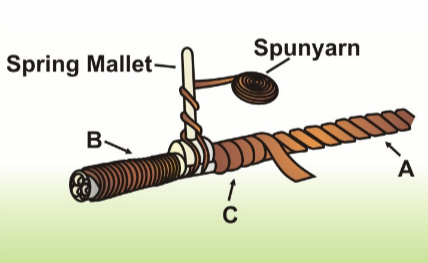Welcome to the website where you can pass online the Seafarer Evaluation Training System (SETS) test on «RS3: Deck Maintenance ». Practice like this will help you as a marine specialist improve your knowledge with the help of online studying and appraisal practice. SETS based on practical information and marine specialists experience.
SETS tests developed for evaluating seaman basic knowledge by company “Naval Education Services ” is an evaluating online-tool, used for revealing any professional preparation needed in specific fields of knowledge, defined by STCW Section A-V/1-2.
SETS tests have proven themselves as good tools for the selection and recruitment process, as well as advancing the level of knowledge of the current officers and crew.
Current test contains SETS questions in area «RS3: Deck Maintenance ». Those questions can be used for competence verification specialist capable of preventing accidental situations related with transporting safety, or also for self-examination.
«RS3: Deck Maintenance » subject includes theoretical and practical information about advanced training for work on any type of vessel. This comprehensive test evaluates a candidate’s knowledge and understanding of advanced deck maintenance procedures for various vessel types. It covers critical areas such as the inspection, upkeep, and repair of deck machinery, including winches, windlasses and cranes. A significant portion of the assessment focuses on the properties, application and maintenance of different surface coatings and anti-corrosion systems used in marine environments. Participants are tested on their knowledge of routine maintenance schedules, safety protocols and the use of specialized tools and equipment for deck work. The exam includes scenarios requiring the identification of common defects in deck structures and the appropriate methods for their repair. Practical knowledge of rigging, wire rope and splicing techniques, essential for safe vessel operations, is a key component of the evaluation. Understanding the procedures for the maintenance of safety equipment, such as lifeboats, davits and fire-fighting systems, is also rigorously examined. Successfully passing this test demonstrates a mariner’s proficiency in ensuring the vessel’s deck department operates safely, efficiently and in compliance with industry standards.
On this site SETS on the subject «RS3: Deck Maintenance » contains 70 questions you need to answer with no possibility to go back to previous question. Therefore, we recommend carefully reading each question and making decision with no hurry. In case you have some difficulty answering, you have also possibility to request a hint.
Use the search below to find question.
Amount of questions: 70 .
Right answers marked with this sign
Which deckhands are not permitted to work aloft?
years who have less than 1 year experience.
When engaged in deck maintenance work or mooring operations, what sort of gloves should be worn?
When working over the ship’s side on staging, what other equipment besides a safety harness should be worn?
When must you wear breathing apparatus?
When must you wear a safety harness?
What protective equipment must be issued to each deckhand for everyday use?
What is a permit to work?
Which of the following maintenance features does not apply to deck cranes?
Which of the following does not have to be carried out on steam powered deck machinery?
Compressed air lines on deck usually suffer from which problem more than the others?
Liferafts are sent for re-packing and checking every:
years .
months .
years .
Which of these maintenance tasks, carried out on winches is considered the most important?
Which of the following need not be tested weekly?
Occasionally a MacGregor hatch may pull from side to side. This could be due to:
Which of the following faults would you consider less serious on a fire hydrant?
Which of the following does not apply to electrically powered deck machinery and cables?
What does the maintenance of lifeboat davits consist of?
years .
Before using deck machinery powered by hydraulics which of the following would you NOT have to do?
Which of the following parts of a MacGregor hatch require the most maintenance?
The outside of deck cranes, derricks and hatch coamings all need protecting with:
Which of the following is NOT important if you are replacing a worn shackle?
After a lifting block has been dismantled, cleaned and reassembled, which of the following is checked?
How are the moving parts of deck equipment maintained?
Which of these should not be done when preparing steel for painting?
What type of paint should be applied to aluminium?
On what parts of the ship are fire retardant paints used?
Where is cement wash applied?
Where is bituminous paint applied?
Where is anti-fouling paint applied?
Where is top-side paint applied?
Where are non-slip paints applied?
To protect wire ropes, what must you ensure?
When sewing or repairing canvas, what must you ensure doing with seaming twine (thread)?
For wood fittings within the accommodation, what sort of paint should be used?
What causes blistering on paintwork?
Before painting, varnishing, or oiling woodwork; what must be ensured?
Which of these statements is not correct?
Who certifies that a space is gas-free and safe for hot or cold work?
AB .
What is “hot work “?
degrees C or 113 degrees F.
What is “cold work “?
Which of the following must be present for rusting to occur?
What corrective action would you take if, when spraying a bulkhead, the paint developed into runs?
Paint used in engine rooms needs to be:
Which of the following combine with steel to form rust?
Which of the following properties is not true of gloss paint?
For the protection of a deep tank that carries edible oils, which of the following coatings is most suitable?
When leaving paint spraying equipment for a long period, the gun should be:
Which of the following, when mixed together with a pigment and a solvent, make up a basic paint?
Which of the following tools would be best for removing rust from large flat areas?
Which of the following would you use to remove salt and dirt from a painted surface?
Where is “self polishing ” paint used?
The thinners used with a gloss paint is:
When working with air-less paint spraying equipment, which of the following is NOT true?
High Pressure ” and/or the test pressure.
Varnish is best removed from large wooden areas with which of the following?
A chipping hammer would be used for which of the following?
A large metal surface is best cleaned and prepared for painting using which of the following?
A paint which is resistant to oils would be used in which of these spaces?
The solvent used with emulsion paint is which of the following?
Chain lockers and machinery seatings would be protected with which of the following?
Which of the following paints would be used inside the accommodation?
Which of the following types of paint is used on the ship’s bottom?
Flat, Round, Dog Leg, Sash Tool, and Pencil are all types of:
A basic paint is made up of:
The air-less type of paint spraying equipment would be most suitable for:
When working with air-less paint spraying equipment which of the following is NOT true?
high pressure ” or with a test pressure.
On which part of the ship would gloss paint be used?
A calcium based primer is used instead of a lead based primer when which of the following is present?
Which of the following would be best for painting large areas?
An epoxy non-contaminant paint would be most suitable for which of the following?
The picture shows the process which takes place after a wire splice has been completed. What is the process marked as “B “?


